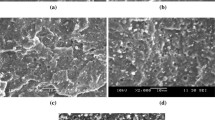Abstract
Crystal-to-crystal transitions of a high-temperature nylon, poly(2-methtyl pentamethylene terephthalamide, nylon M5T), were studied by conventional and modulated temperature DSC (DSC and MT-DSC, respectively), as well as modulated thermomechanical analysis (MT-TMA), wide-angle X-ray scattering (WAXS), dynamic mechanical analysis (DMA) and hot stage microscopy. This polymer can easily be quenched to the completely amorphous phase at a cooling rate as low as 80 °C min−1. This polymer has three different crystal forms plus a smectic phase, and these crystal forms change into each other during a continuous heating of the amorphous polymer as evidenced by MT-DSC, MT-TMA, DMA and WAXS. The crystal-to-crystal transitions of two vastly different molecular masses were investigated: One was prepared by polycondensation followed by chain extension (see Menczel et al. J Thermal Anal 46:753, 1996), and the other sample was made by simple polycondensation. Tg of the amorphous polymer (including the as-spun fiber) is 143 °C, which is about 25 °C higher for the drawn fiber. The crystal-to-crystal transitions take place between 170 and 290 °C. MT-DSC and DMA measurements (the reversing heat flow signal and the tensile storage modulus of the as-spun fiber) proved that these crystal-to-crystal transitions take place through melting. Efficient nucleating agents (carbon nanofibers) do affect the temperature of these transitions as well as the melt-to-crystal transition during cooling of the melt and also during heating of the amorphous polymer. Polarization optical microscopy observations suggest that the highest temperature crystal form obtainable in high-temperature melt isothermal crystallization is probably a smectic, and this phase changes to some spherulitic structure during further cooling. Non-isothermal and isothermal crystallization measurements let us conclude that the two high-temperature crystal forms (smectic and crystal form C) are thermodynamically stable (enantiotropic), while the two low-temperature crystal forms are metastable (monotropic). The Hoffman–Weeks method gave 339 °C for the equilibrium melting point of this polymer. DMA experiments gave three secondary transitions. A transition at ~ − 120 °C was assigned to a local mode relaxation of the methylene groups. The transition at − 65 °C corresponds to the onset of rotation of the amide groups, while another secondary transition at 63 °C is the onset of rotation of the phenylene groups.



















Similar content being viewed by others
References
Menczel JD, Jaffe M, Saw CK, Bruno TP. Thermal analysis of poly (2-methylpentamethylene terephthalamide). J Therm Anal Calorim. 1996;46:753.
Menczel J, Wunderlich B. Heat capacity hysteresis of semicrystalline macromolecular glasses. J Polym Sci Polym Lett Ed. 1981;19:261.
Wunderlich B. Study of the change in specific heat of monomeric and polymeric glasses during the glass transition. J Phys Chem. 1960;64:1052.
Frosini V, Butta J. Some remarks on the mechanical relaxations in aliphatic, partially aromatic and wholly aromatic polyamides. J Polym Sci Polym Lett Ed. 1971;9:253.
Author information
Authors and Affiliations
Corresponding author
Additional information
Publisher's Note
Springer Nature remains neutral with regard to jurisdictional claims in published maps and institutional affiliations.
Rights and permissions
About this article
Cite this article
Menczel, J.D. Crystal-to-crystal transitions in nylon M5T. J Therm Anal Calorim 143, 3085–3092 (2021). https://doi.org/10.1007/s10973-020-09394-4
Received:
Accepted:
Published:
Issue Date:
DOI: https://doi.org/10.1007/s10973-020-09394-4



